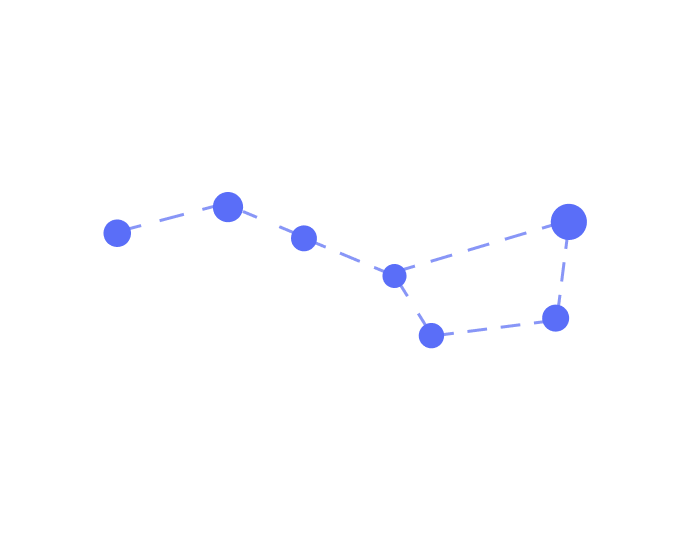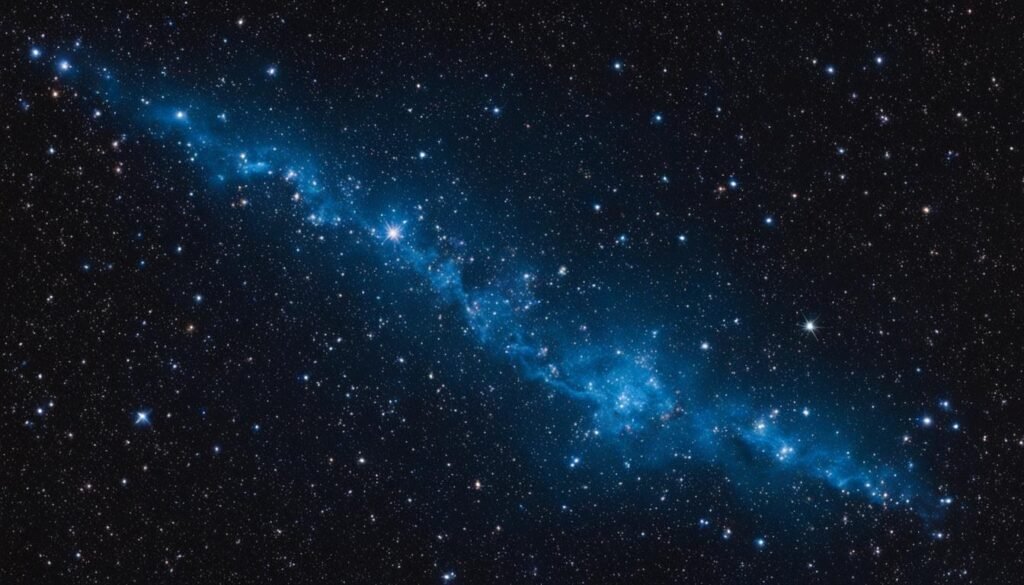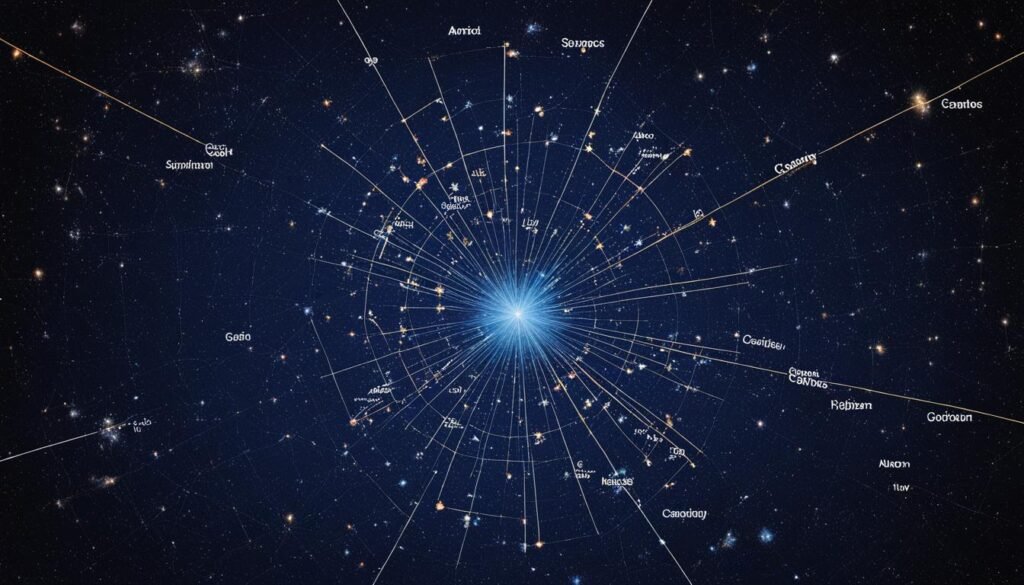
| Genitive | Carinae |
| Abbreviation | Car |
| Pronunciation | (kəˈraɪnə, kəˈriːnə) |
| Main Stars | 9 |
| Brightest Star | Canopus (α Car) (−0.72m) |
| Right Ascension | 6 hours to 11 hours |
| Declination | -50 deg to -75 deg |
| Sq. Deg. Area | 494 |
| Crosses Meridian | 9PM, Mar |
| Visible Lat. Range | +20, -90 deg (°) |
| Best Viewing Season | Spring (Southern Hemisphere) |
Embark on a celestial journey through the southern skies where the Carina constellation sails across the cosmos. With its storied past and brilliant luminaries, Carina has captivated stargazers for centuries. Discover the facts that make this constellation not only significant in our exploration of the night sky but also in its representation of history and mythology. As you delve into the Carina constellation facts, you’ll uncover the essence of this celestial feature— from the mythological ship that ferried Jason and the Argonauts to the birth and death of stars that punctuate the heavens.
Understanding the Carina constellation history is an enriching experience that transcends simple observation. From its origins as part of the colossal Argo Navis to its status as a stand-alone constellation, Carina’s transformation mirrors the evolution of astronomy itself. With Carina constellation information spanning from ancient myth to the light of Canopus, your grasp of the cosmos will expand with every shining star in this stellar assemblage.
Key Takeaways
- Carina constellation represents a rich chapter in celestial navigation and mythology.
- Canopus, a beacon in the night, is one of the most vibrant stars in the Carina constellation.
- The impressive size and diverse stellar composition make Carina a fascinating subject for astronomers.
- Deep sky treasures like the Carina Nebula are critical markers in understanding cosmic phenomena.
- Carina’s astronomical significance is matched by its cultural impact, spanning various civilizations.
- The splitting of Argo Navis into Carina and its neighboring constellations marked a pivotal moment in star charting history.
An Astronomical Voyage: Exploring Constellation Carina
Embark on a celestial journey through the Carina constellation, a marvel among the twinkling beacons of the night sky. This section will unfold the tapestry of Carina’s vast cosmic landscape, delve into its rich mythological roots, and recount its historical significance that continues to guide modern stargazers.
Unveiling Carina’s Cosmic Landscape
Residing in the southern celestial hemisphere (SQ2), the Carina constellation location can be pinpointed at latitudes between +20° and -90°. Its impressive expanse covers 494 square degrees, making it the 34th largest constellation known. Few cosmic vistas can compete with the majestic beauty that Carina offers with its glittering Carina constellation stars and nebulous wonders. Your gaze will meet with not only the luminous Canopus and famed Eta Carinae but also with the sprawling Carina Nebula and the alluring Theta Carinae Cluster.
For those enthralled by the vast universe, the Carina constellation map serves as an invaluable tool, guiding you through a family of constellations known as the Heavenly Waters. If you follow the celestial coordinates, you’ll find Carina in the grand company of neighboring Vela and Centaurus, a testament to the intertwined nature of the cosmos.
The Etymology and Mythology Behind the Constellation
The name “Carina” is derived from the Latin for “the Keel”, paying homage to its depiction of a ship’s keel within the once-larger constellation Argo Navis. Although Carina constellation mythology may not stand separate from its predecessor, it inherits a rich narrative tapestry. According to legend, Argo Navis was the vessel constructed by the mythical artisan Argus. A gifted oak beam ensconced within its structure could utter prophecies, a divine endowment from Zeus’ sanctuary at Dodona.
Renowned among the stars is Canopus, a name inspired by Menelaus’ helmsman from the epic saga of Helen of Troy. This Carina constellation name is not simply a term; it’s a strand woven into the rich tapestry of storied skies that have guided humanity through time.
The Partition of Argo Navis and Emergence of Carina
In an astronomical reshaping comparable to the odysseys of yore, Carina was cleaved from Argo Navis to sail the heavens as its entity. This discerning segmentation conducted by Nicolas Louis de Lacaille in the 18th century provided astronomers with a finer grid for celestial navigation, marking the birth of Carina constellation features in their own right.
Today, constellation Carina history is not merely a chapter in astronomical textbooks; it’s an ever-present compass in the sky, guiding enthusiasts to discover its distinguished shape and stories. With stars like Canopus symbolizing the keel’s blade, Carina’s illustrious past is anchored firmly within the cosmic ocean where Jason and the Argonauts are everlastingly memorialized.
Carina Constellation Features and Notable Stars
The Carina constellation is a veritable treasure trove of astronomical wonders, home to some of the most brilliant and discussed stars in the galaxy. As your gaze drifts across the southern sky, you’ll encounter not just an array of luminous bodies, but also pieces of a grand cosmic puzzle waiting to be deciphered.
Canopus, an F-type bright giant, stands as the cornerstone of Carina. Amidst the Carina constellation stars, it boasts an extraordinary magnitude that has guided mariners through the ages. As the second-brightest star in our night sky, located a mere 310 light-years from our planet, its glow serves as a beacon for cosmic explorers.
In contrast to the steady shine of Canopus, the Eta Carinae system tells a story of unpredictability and astronomical intrigue. This luminous blue variable star has captured the curiosity of observers due to its dramatic outburst in the 19th century and its potential as a future supernova. It is a binary system with at least two primary components, adding complexity to its already mysterious nature.
To truly appreciate the stellar tapestry Carina weaves, one must recognize the significant stars that contribute to its grandeur. Here is a table highlighting the primary luminaries that make up the Carina constellation.
| Star Name | Spectral Type | Luminosity (Relative to Sun) | Distance from Earth (Light-years) |
|---|---|---|---|
| Canopus | F-Type Bright Giant | ~10,700 | 310 |
| Eta Carinae | Luminous Blue Variable | ~5,000,000 | 7,500 |
| Miaplacidus | A-Type Main-Sequence | ~1,740 | 111 |
| Avior | K-Type Bright Giant | ~3,310 | 630 |
| Aspidiske | A-Type Bright Giant | ~6,090 | 700 |
| Aiolos | Unknown | Unknown | Unknown |
| Tapecue | Unknown | Unknown | Unknown |
Each star within Carina plays its part in the constellation’s lore and composition. The naming of these celestial bodies often has historical significance, echoing stories from various cultures and time periods. As you familiarize yourself with these names and their positions in the sky, the Carina constellation becomes more than a cluster of stars—it becomes a gateway to understanding the vast and intricate universe we are a part of.
Discovering the Carina Constellation’s Historical Significance
As you gaze into the night sky, the Carina constellation information that we possess today is the culmination of centuries of astronomical observations and cultural significance. Originally an integral part of the now obsolete superconstellation Argo Navis, Carina has sailed across the celestial sphere carrying its own tales of myth and navigational import.
The constellation Carina history can be traced back to ancient times. Famed astronomer Claudius Ptolemy, who catalogued Carina as part of the vast Argo Navis, laid the groundwork for the modern understanding of its boundaries and content. However, it was Nicolas Louis de Lacaille’s 18th-century interventions that detached Carina from its parent constellation, providing a distinct identity and simplifying the sky mapping process for future generations.

Below is a tabulated view of the significant moment in Carina’s history that shaped how we perceive this constellation:
| Event | Astronomer | Era | Impact on Carina |
|---|---|---|---|
| Initial Cataloguing | Claudius Ptolemy | 2nd century CE | Identified as part of Argo Navis |
| Re-categorization | Nicolas Louis de Lacaille | 18th century CE | Separated Carina from Argo Navis for precision |
| International Recognition | International Astronomical Union (IAU) | Early 20th century | Established clear celestial borders |
The historical reformation of what was once part of a mythical ship into its own navigational feature reflects the continuous evolution of astronomy—a field always looking up and moving forward. The legacy of Greek mythology, with tales of Jason and the Argonauts, endows Carina with an everlasting narrative, grounding its astral presence in our collective memory. As you absorb this knowledge, remember that the stars of Carina have steered human fascination just as they have guided sailors throughout the ages.
Navigating the Night Sky: Carina Constellation Location and Observation
Whether you’re an amateur stargazer or an experienced astronomer, understanding the Carina constellation location and the best time to view the Carina constellation can enrich your celestial experience manyfold. For those keen on exploring the southern skies, the Carina constellation offers an exceptional stargazing journey.

Best Time and Locations to View Carina
If you reside in the Southern Hemisphere or near the equator, you’re perfectly positioned to observe Carina’s brilliant clusters and nebulae. The prime viewing months are during the local summer, where the constellation makes its majestic appearance, allowing you to witness its grandeur under ideal conditions. Optimally, for those located at latitudes between +20° and -90°, these months provide the clearest skies for constellation observations.
Mapping the Stars: Tools for Skygazers
To navigate the night sky with confidence, you’ll need the right tools for observing constellations. A Carina constellation map is invaluable for identifying this constellation’s specific star patterns. Resources provided by the International Astronomical Union (IAU) and Sky&Telescope magazine offer expertly crafted star charts and sky maps to guide you through the wonders of the Carina constellation.
- Sky maps for a detailed overview of the constellation’s location
- Star charts that pinpoint each star within Carina
- Mobile apps equipped with augmented reality, highlighting and naming the stars as you scan the sky
- Telescopes or binoculars enhancing your view of Carina’s distant suns and nebulae
Armed with these tools and your newfound knowledge of the Carina constellation, you’re all set to embark on a journey through the stars, uncovering the secrets of one of the most captivating clusters in our galaxy.
A Deeper Dive into the Carina Constellation’s Unique Attributes
Within the expanse of the Carina constellation, you will find a treasure trove of celestial phenomena that paints a spectacular picture of stellar evolution. This constellation is not just a cluster of distant suns; it is a laboratory in the sky where the life cycles of stars can be observed and studied. The Carina constellation stars, especially Canopus and Eta Carinae, play a critical role in our understanding of the cosmos.
The Luminosity and Secrets of Canopus and Eta Carinae
Canopus, a beacon of light in the southern sky, is famed for its brilliance. Its radiant light has guided seafarers for centuries, and to this day, its exceptional luminosity makes it a cornerstone amongst the Carina constellation features. Remarkably, it remains above the horizon year-round for observers south of latitude 37 degrees. Your gaze upon Canopus connects you to a star that is believed to have reached its mature phase of stellar evolution.
Eta Carinae’s story is one of intrigue and mystery, a star system known for its dramatic fluctuations in brightness and the Great Eruption of the 19th century. Now quietly simmering in the Carina constellation, Eta Carinae serves as a constant reminder of the unstable life of a luminous blue variable, a star approaching the grand finale of its life—the supernova.
Understanding Stellar Evolution within Carina
Stellar evolution is vividly on display in the Carina constellation, from birth within nebulae to the various stages of stellar maturity. Its stars offer a unique perspective on the life cycles of celestial bodies. As we explore deeper, we uncover not only the individual characteristics of its stars but also the collective narrative they weave about the universe’s evolution.
| Star Name | Type | Notable Features | Contribution to Stellar Evolution Studies |
|---|---|---|---|
| Canopus | F-Type Bright Giant | Extreme brightness, visible year-round from certain latitudes | Exemplifies late stages of stellar life for massive stars |
| Eta Carinae | Luminous Blue Variable | Historical brightness variations, Great Eruption | Provides insight into the tumultuous phases preceding supernovae |
| Various Nebulous Stars | Young Stellar Objects | Surrounded by nebulosity, indicative of recent formation | Sheds light on the initial stages of star birth and cluster formation |
Armed with the knowledge of Canopus and the enigmatic Eta Carinae, you are witnessing the story of our universe’s growth, from stellar nurseries to the grandeur of supernova explosions. The Carina constellation doesn’t just decorate the night sky; it is a dynamic landscape where the past, present, and future influences of stellar evolution are unraveling before our eyes.
Constellation Carina and its Celestial Neighbors
As an avid stargazer, you’re likely familiar with the Carina constellation neighbors that form a stellar society in the night sky. But have you realized how pivotal this astral region is for navigation? Carina, a significant part of the Heavenly Waters family, is surrounded by constellations that have guided explorers across oceans for centuries. Many of the constellations adjoining Carina have been essential navigational constellations for sailors navigating the unpredictable seas.
- Vela: Once part of the ancient super-constellation Argo Navis, Vela represents the sails of the ship.
- Puppis: The stern of the legendary vessel, offering a backdrop to Carina’s keel.
- Centaurus: A kingly figure in the sky, neighboring Carina and serving as a guide toward the galactic center.
- Musca: The Southern Fly, small yet significant in the ocean of stars.
- Chamaeleon: Reflecting the adaptive nature of the cosmos, this constellation twinkles close to Carina.
Their collective splendor is more than a cosmic ornament; it’s a testament to the resourcefulness of our ancestors and the boundless wonders above. Let’s enjoy the majestic tapestry woven by Carina and its counterparts, as it has been admired and utilized for millennia.
The Cultural Tapestry: Carina Constellation in Myth and Legend
The Carina constellation mythology weaves a narrative as rich and varied as the cultures that have chronicled its journey across the night sky. For ancient civilizations, Carina didn’t merely exist as a collection of stars; it represented a vessel on an epic voyage, imbued with stories of adventure and survival. As you explore the celestial keel of Carina, you tread a path laid by the imaginative tales of Greek mariners, Egyptian lore, and the cosmic interpretations of Indian astronomers.
In the annals of constellation Carina history, the Greeks regarded the constellation as a symbol of the Argo, the honored ship that bore Jason and his warriors on their quest for the Golden Fleece. Steering the Argo was none other than Canopus, whose namesake today is assigned to Carina’s brightest star. Meanwhile, the Egyptians envisioned this cluster of stars as a divine vessel that charted the skies during cataclysmic floods. Such tales exemplify the star’s influence on human culture, serving as celestial touchstones that guided spiritual beliefs and storytelling traditions.
Even though these civilizations are long gone, the tradition of star-based storytelling endures every time you gaze upon Carina’s stars. They remind us that our ancestors sought comfort and meaning in the night sky, using Carina as a focal point for narratives that endeavored to explain and navigate the world around them. As you contemplate the constellation’s majesty, consider how it echoes our unending quest to connect with the cosmos and the stories we create under its timeless gaze.
FAQ
What is the Carina constellation and why is it significant?
The Carina constellation is a prominent constellation in the southern hemisphere that was once part of Argo Navis. Its most notable star is Canopus, the second brightest star in the night sky. Carina plays a significant role in the history of astronomy and is rich with stars and deep sky objects, making it important for both scientific study and cultural mythology.
What are some of the most notable stars in the Carina constellation?
Notable stars in the Carina constellation include Canopus, an F-type bright giant, and Eta Carinae, a luminous blue variable binary star system. There are also six named stars within Carina: Aiolos, Aspidiske, Avior, Canopus, Miaplacidus, and Tapecue.
What is the mythology associated with the Carina constellation?
The Carina constellation itself does not have a distinct mythology, but it was originally part of the Argo Navis constellation, which is associated with several mythologies, including the Greek story of Jason and the Argonauts. Within these narratives, the constellation symbolizes parts of a ship that embarked on epic voyages and adventures.
How was the Carina constellation historically identified and cataloged?
The Carina constellation was first cataloged by the Greek astronomer Ptolemy in the 2nd century CE as part of the larger constellation Argo Navis. It wasn’t until the 18th century that Nicolas Louis de Lacaille divided Argo Navis into smaller constellations, including Carina, for easier celestial navigation.
When is the best time to observe the Carina constellation?
The best time to observe the Carina constellation is during the local summer months in the Southern Hemisphere. It is visible from latitudes between +20° and -90°, making it prominent in the southern sky for observers located in the Southern Hemisphere or at low northern latitudes.
What tools can help identify and observe the Carina constellation?
Tools like sky maps and star charts from reputable sources such as the International Astronomical Union (IAU) and Sky&Telescope magazine can help stargazers locate and appreciate the Carina constellation, its individual stars, and its neighboring constellations.
Why is the star Canopus important in the Carina constellation?
Canopus is the second brightest star in the night sky and a key navigation star due to its extreme brightness. It is also part of the Scorpius-Centaurus Association, a notable star group, and is significant for celestial navigation due to its visibility from many parts of the Earth.
How does the Carina constellation contribute to our understanding of stellar evolution?
The Carina constellation is home to a range of star types and stages of stellar evolution. Observing stars such as Canopus and Eta Carinae, as well as other stars and star clusters in Carina, provides valuable insight into the life cycles of stars and the dynamics of stellar phenomena like supernova impostor events.
What constellations are near the Carina constellation?
The Carina constellation is part of the Heavenly Waters constellation family and is neighbored by constellations such as Vela, Puppis, Centaurus, Musca, and Chamaeleon. These nearby constellations enrich the navigational matrix used by ancient mariners and modern stargazers.
How has the Carina constellation been interpreted in different cultures?
Different civilizations have interpreted the Carina constellation through their unique mythological contexts. For the Egyptians, it represented a ship that traversed a great flood, while the Greeks focused on the story of the Argo. Such interpretations reflect how different cultures have historically found meaning and guidance in the stars.






